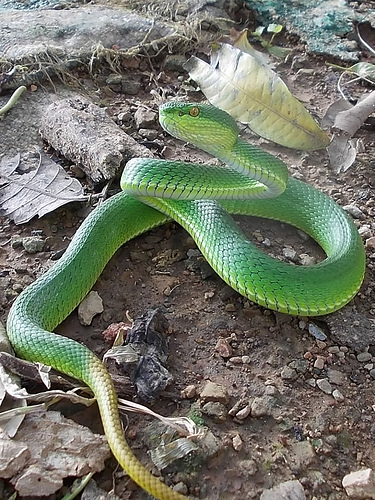This is a guest post by Geography and You team.
The United Nations’ (UN) Convention on Biological Diversity (CBD) defines biodiversity or ‘biological diversity’ as “the variability among living organisms from all sources including, inter alia, terrestrial, marine and other aquatic ecosystems and the ecological complexes of which they are a part; this includes diversity within species, between species and of ecosystems” (UN, 2018).
Dr. C. R. Babu, a senior Environmental Scientist at Delhi University, defines biodiversity as, “All kinds of living organisms and their environments and together with their interactions constitute biodiversity. In other words, all kinds of plants, animals and microbes found in the biosphere and their environment, together with their interactions are collectively referred to as biodiversity”.
Babu extrapolates that there are four categories of biodiversity. The first category of biodiversity is what is known as genetic biodiversity. It refers to the differences among the living organisms in terms of genes, genetic material or DNA or genomes. The second kind of biodiversity is what is known as species biodiversity. It refers to the kinds of species found in the biosphere. The third category is what is known as ecosystem biodiversity. It refers to the different kinds of ecosystems that are found in the biosphere. The fourth category of biodiversity is what is known as human cultural biodiversity. This refers to diversity in languages, religions, food habits and other lifestyles among human populations.
Read More: Drones to Monitor 10 Biodiversity Hotspots in India
Legal Mechanisms for Biodiversity in India
After the UN’s Convention on Biological Diversity (CBD) came into force on December 29th, 1993 the Biological Diversity Act was enacted by India in 2002 pursuant to the CBD. This was followed by India’s notifying of the Biological Diversity Rules in 2004 to provide effect to the provisions of the CBD and the Biological Diversity Act, 2002. The Act pervades three institutional levels in government, namely the national, state and local levels. In 2003 the National Biodiversity Authority (NBA) was set up in Chennai. The NBA consists of a chairperson and representatives from various ministries making up 5 non-official and 10 ex-officio (by virtue of one’s position or status) members as appointed by the Central Government (MoEF, 2018).
The NBA aims broadly at conservation and sustainable use of India’s biodiversity along with better management and applications in how India’s biological resources are used including also encouragement of people’s participation in the processes to these ends. The organization’s mission is to pursue the efficient practice of the provisions of the Biological Diversity Act, 2002 and the implementation of the Biological Diversity Rules, 2004 in order to efficiently manage biodiversity in India and ensure equitable sharing of benefits that can arise from the utilization of biological resources.

The Biological Diversity Act, 2002 covers aspects of biodiversity that deal with its conservation, and also utilization for research, commercial, or bio-survey and bio-utilization purposes. A framework is provided by the Act for access to biological resources and distribution of benefits that can come about due to access to and use of biological resources. The Act also covers Intellectual Property Rights (IPR) regarding biological resources in India including the transfer of results from research and other applications of IPR. The Act orients action to be initiated by individuals or entities when dealing with biological resources in India to be carried out with the approval of the NBA as under the provisions of the Biological Diversity Act, 2002 when they use or access biological resources or knowledge associated with biodiversity.
Read More: Indian Biodiversity Under Serious Threat
In requiring the approval of the NBA, in terms of individuals and entities, the Act includes non-resident Indians, foreigners, corporations and organizations that are not incorporated in India or those that are incorporated in India with non-Indian participation in its management and in its share capital. The approval of the NBA is not required by Indian citizens and Indian institutions in undertaking the aforementioned activities. However, if they intend to organize any commercial research, they need to inform the respective State Biodiversity Boards. They also require approval from the NBA for any IPR based applications of biological resources.
The Act however excludes from its purview biological resources in India that are traded as commodities and as commodities only and for no other purpose. Also excluded from the provisions of the Act are traditional uses of biological resources and the knowledge associated with these and also when Indian and foreign institutions engage in collaborative research projects that have the approval of the Central Government (NBA, undated).
Apart from the NBA in association with the State Biodiversity Boards and Biodiversity Management Committees, many other institutions in India contribute to the conservation and sustainable use of biological diversity in India. The NBA is also aided in its work by the Ministry of Environment and Forests (MoEF) and various government departments such as the Animal Welfare Division and the Central Pollution Control Board of the MoEF for example. The conservation and sustainable use of biological diversity in India is also supported by various other organizations and educational institutions such as the Indian Institute of Bio-Social Research and Development which is associated with the MoEF.
For example, in accordance with Article 6 of the CBD, which requires all parties to develop strategies and programmes for the conservation and sustainable use of biological diversity, the MoEF implemented the National Biodiversity Strategy and Action Plan (NBSAP) as an externally aided project from 2000-2004. It involved thematic action plans at the state, eco-region and local levels. In 2006 after the cabinet approved the National Environment Policy the preparation of the National Biodiversity Action Plan (NBAP) was initiated. The cabinet approved the NBAP in 2008 and formally released in 2009. The NBAP mainly focuses on conservation of biological diversity taking into account the existing legal frameworks, strategies and plans and programmes on the basis of which the action plan is designed (MoEF, 2018).
Biodiversity Hotspots in India and Conservation
The term biodiversity hotspot was framed by the biologist Norman Myers in 1988 who defined it as a biogeographical region whose levels of plant endemism is exceptional and which is marked by serious levels of habitat loss. Conservation International (CI) undertook a reassessment of this definition in 1996 which was followed by an extensive global review three years later which introduced quantitative demarcations in how biodiversity hotspots were designated. For Conservation International, to qualify as a biodiversity hotspot, a region would require two criteria. These include having a minimum of 1,500 species of endemic vascular plants, and the region needs to have a minimum of 70 per cent of its original habitat lost.
Read More: Facts you Did Not Know About Biodiversity of India
The Botanical Survey of India lists 4 principal biodiversity hotspots in India whose span can in some cases extend to regions outside the boundary of India. This includes first, the Indian portion of the Himalayas and also includes the Himalayan region in other countries such as in China, Nepal, Pakistan, Bhutan and Myanmar. Second, the Indo-Burmese region which includes all of northeastern India except the state of Assam and also internationally includes the Indo-Burmese region as a whole including Myanmar, southern China, Thailand, Cambodia, Vietnam and Laos. Third, another biodiversity hotspot is the Sundaland region consisting of the Nicobar group of islands in India and Malaysia, Indonesia, Brunei, Singapore and the Phillipines abroad. Fourth, is the biodiversity hotspot comprising of the Western Ghats along India’s south-western coast and the biodiversity hotspot also includes the nation of Sri Lanka (NIC, 2011).
Science has identified about 1.4 million organisms globally and new species are still being discovered.
In this India is one of the world’s 12 mega-biodiversity centres, including being among the 6 centres of origin of agronomic crop species identified by the botanist N.I. Vavilov. In India more than 89,000 animal species and about 45,000 plant species have been identified which makes up about 6.5 per cent of all known species.
Among India’s biological diversity hotspots, two of them are particularly threatened. These are the eastern portion of the Himalayan region and the Western Ghats (Balaji, 2010). The WWF estimates that about 75 per cent of Himalayan habitats have been destroyed or degraded (WWF, 2017). At least 325 globally threatened species are in the Western Ghats which is home to a large number of endemic plants and animals.
Legal documents for conservation of biological diversity usually act as umbrella policies for many micro-level activities to take place. The most prominent of these activities can include demarcating certain areas as protected areas, which can be a method to conserve habitats, although not all habitats. Also other methods like mapping of sites, identifying gap species (being certain species not covered by habitats within protected areas), listing of certain species by the IUCN in the Red List such that renewed efforts are made for the conservation of these species, alternately making Red List Indices that look at the projected extinction risk of certain sets of species in terms of temporal variability, etc (Mandal & Nandi, 2009) can facilitate conservation of biological diversity apart from demarcating certain areas as protected areas. Alternately resource allocation policies can also assist in conservation of biological diversity along with policies for the restoration of natural habitats.

A growing number of species are increasingly being threatened in India mainly because of conversion of forest lands to agriculture, changing land use patterns in development and industrial activities such as the construction of dams and blasting of mines for example which together are degrading habitats for species in India. Some of these species threatened are endemic to India such as the one-horned rhinoceros and the Gangetic dolphin. Their extinction in India could mean their global extinction. A loss in biological diversity can impact not only flora and fauna but also humans and their economy, severely affecting livelihoods when the source for products based on biological products disappear or become threatened (Vyawahare, 2017).
Access & Benefit Sharing Issues
The NBA claims that India’s experience with access and benefit sharing (ABS) issues has been progressive. One of the most notable early examples they cite is the impact of recognizing the traditional knowledge of India’s Kani tribe about a plant called Arogyapacha. The local communities were rewarded with providing their knowledge and the genetic resources that paved the way for the development and commercialization of a drug called Jeevani, which is an anti-fatigue drug. This ABS issue occurred before the CBD came into force.
The CBD, the Biological Diversity Act, 2002 and the Biological Diversity Rules, 2004 were a huge encouragement in operationalizing the ABS provisions as within these documents. The noteworthy aspect in the history of ABS in India has been in not only engaging experts and policy makers but also engaging communities and India has dealt with over 600 ABS applications. These ABS applications can come under 4 categories vis. those that deal with access to biological resources or traditional knowledge, transfer of research results for commercial purposes, with IPR, and with third party transfer of the biological resources or traditional knowledge.
In the ABS application process, there is a different form that has to be completed for each of these 4 categories. Securing applications is based on securing prior informed consent, satisfying mutually agreed terms and guaranteeing fair and equitable benefit sharing. The NBA is assisted in processing these forms by an expert committee over the benefit sharing component, and consultation with local bodies under whose jurisdiction the access to the traditional knowledge and/or biological resources is secured. The final approval is marked by an ABS agreement signed between the applicant and the NBA (NBA, undated). An ABS agreement is a huge step in bringing about greater equity in access and distribution of benefits over biological resources and traditional knowledge and a practical tool to apply legal policy on the ground.
Read More: Researchers Describe Two New Lizard Species from India
Endnote
Although India has a robust legal mechanism in place to conserve and sustainably utilize biological diversity, action on the ground is necessary given how many species are threatened not just in biodiversity hotspots but also in wild zones across India. The provisions of the Act and the Rules must be applied with a principal focus on protecting habitats and indigenous knowledge. The legal documents aim to regulate the sphere of human activity over biological resources, which is in urgent need of better implementation. A robust legal document in theory must be accompanied with equally strong legal and scientific research, legal practices, legal reviews and policy applications.
This article was originally published in Geography and You and has been re-published here with permission. Read the original here.





